Edited by Barton Lin, Senior Engineer at Technical Support Team, Moldex3D

- Customer: Tsing Hua University
- Region: Taiwan
- Industry: Educational/Academy
- Solution: Moldex3D eDesign Package & Moldex3D RTM Module
Tsing Hua University has developed into a comprehensive research university offering a full range of degree programs in science, technology, engineering, humanities, social sciences, and management. It consistently ranks as one of the premier universities in East Asia and is widely recognized as a leading incubator for future leaders. (Source: https://nthu-en.web.nthu.edu.tw/bin/home.php?Lang=zh-tw)
Executive Summary
Most of the wind turbine blades today are manufactured from composite materials. The composite materials wrap the core material with a certain number of fiber layers to form a sandwich structure, which can effectively reduce the weight of the blades while maintaining structural strength. Currently, most of the core materials are made of PVC and Balsa wood. To facilitate the resin infusion process, grooves with a certain size are cut into the surface of the core. To obtain accurate simulation results, it is necessary to simulate the fiber mat and the grooves simultaneously, which requires a different simulation method from the traditional one.
Challenges
Since the core material contained grooves and channels, the team was tasked not only with simulating the fiber mat but a more complex geometry, and which increased the difficulty in obtaining accurate simulation results.
Solutions
Moldex3D RTM can define and assign different material properties and fiber orientation to each layer, which helps streamline the complex RTM simulation workflow. With the help of Moldex3D RTM’s capability for equivalent permeability simulation, the Tsing Hua team could accurately predict and capture the flow behaviors inside the grooves and the channels, which matched well with the experimental results.
Benefits
- Enable realistic simulation of composite sandwich structures
- Streamlined RTM simulation process to reduce product development time
- Process optimization
Case Study
The existing study often treats the entire reinforcement, including both the core material and the fiber sheets, as a single object and describes the patterns of the resin flow with a single governing equation, i.e. Darcy’s law.
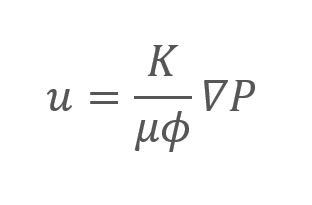
In the equation, u and are the flow velocity and viscosity of the resin, K and are the permeability and porosity of the flow medium, and is the pressure gradient. In such a way, the influences of the Distribution Media and fiber-free region in the core on the flow pattern cannot be decoupled, limiting the accuracy and the flexibility of the developed models.
In this study, the team combines glass fabric and PVC core with the channel as a sandwich structure composite to be our study model (Fig. 1). The experimental method is Vacuum Assisted Resin Transfer Molding (VARTM) (Fig. 2).
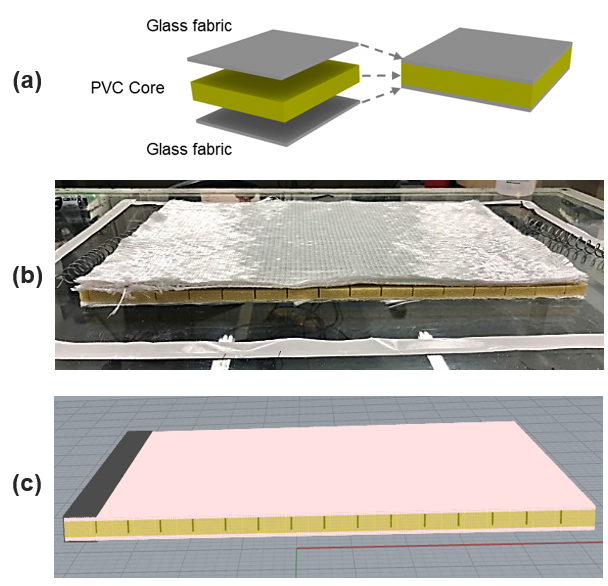
Fig. 1 The model of sandwich structure: (a) schematic diagram, (b) real object and (c) solid mesh for simulation.
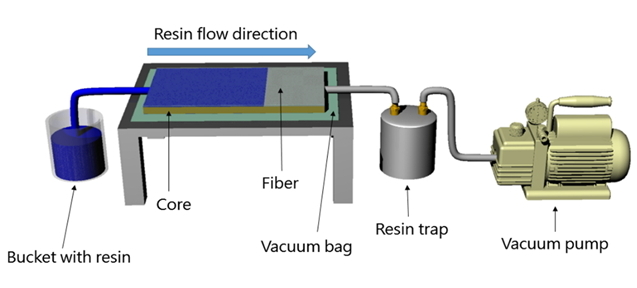
Fig. 2 The experimental method in this study
The team simulated the behaviors of the resin flow within the fiber and the fiber-free region (i.e. the channels) in the PVC core separately by using the finite volume method (FVM) (Fig. 3). The size of the core is 480×320×10.2 mm3. There are two types of channels in the core. The rectangular channels with a width of 1 mm and a height of 8.2 mm are arranged horizontally in a crisscross pattern. The distance between the two nearest parallel channels is about 29 mm. The 408 vertical cylindrical channels with a diameter of 2 mm and a height of 10.2 mm are evenly distributed in the core. The resin flow in the fiber is modeled by using Darcy’s law. After designing the structure of the core material, the flow behavior inside the channels is also modeled via Darcy’s law with the equivalent permeability. In doing this, the entire simulation can be designed using the same type of governing equations, making the boundary conditions relatively easy to set.
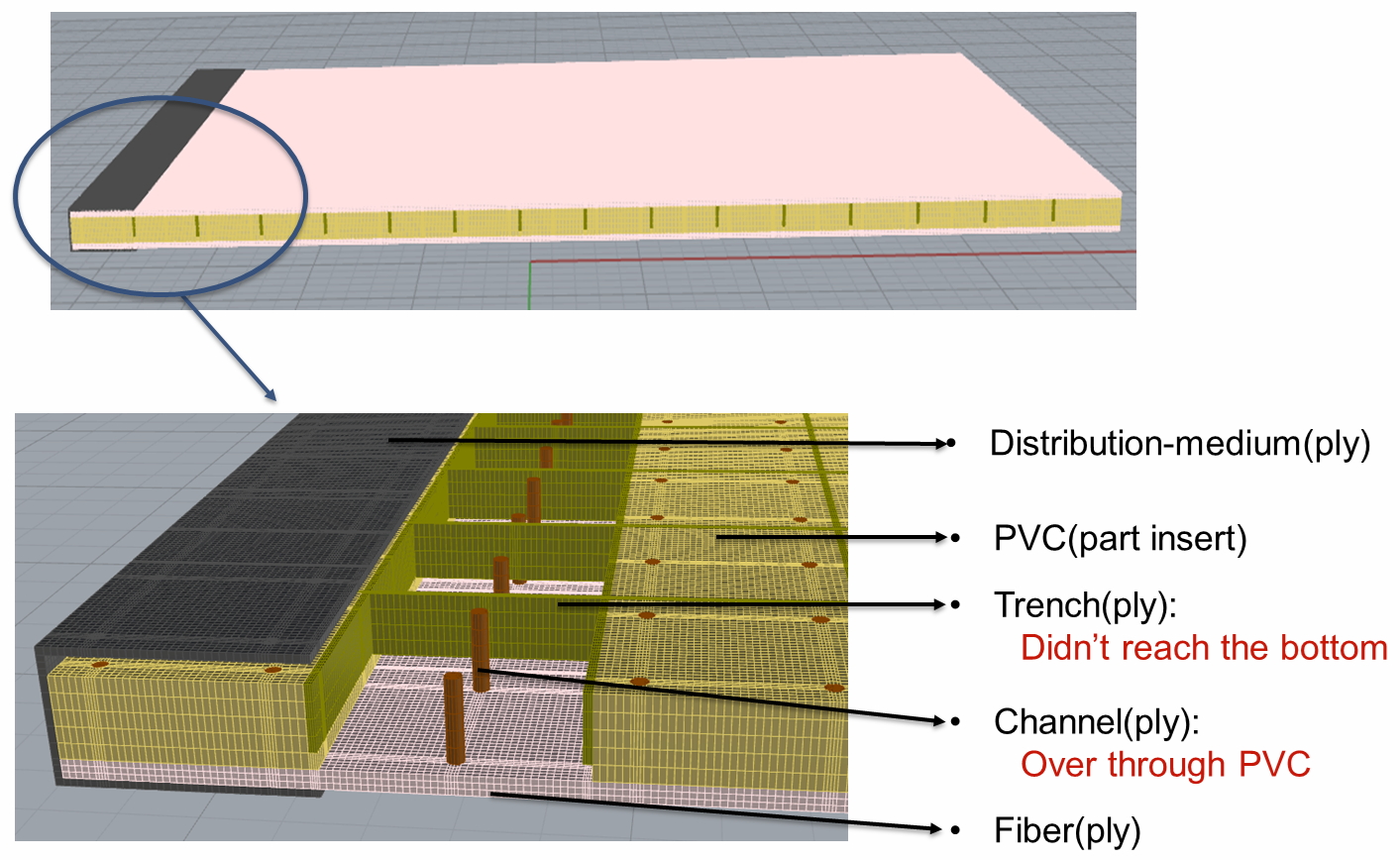
Fig. 3 Solid mesh and attribute setting
The simulation results were compared with the experimental results to illustrate the feasibility of the proposed model. The simulated flow pattern well demonstrates the observed patterns (Fig. 4). Also, the proposed simulation framework has the flexibility to handle various combinations of core materials and fibers, which is a desired feature in industrial practice.
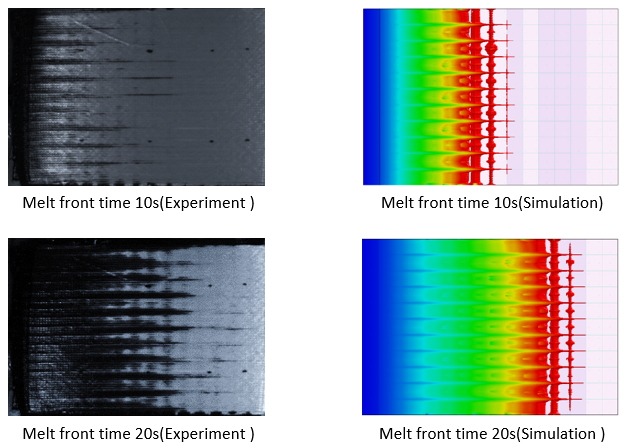
Fig. 4 Melt front time between experiment and simulation.
Results
In this study, the team used the unique equivalent permeability function of Moldex3D RTM to accurately simulate the flow characteristics of the groove and the flow channel in the PVC core material and achieved high consistency of the simulation and experimental results. Through the simulation results, since the experiment can only set the camera frame up and down, the flow in the middle of the core material cannot be observed by the camera, but the Moldex3D visualization platform can simulate the flow condition of the unobservable intermediate core material. The team expect RTM simulation technology to be widely used in composite materials industries such as wind power and automobiles, effectively assisting manufacturers to shorten the optimization cycle.
